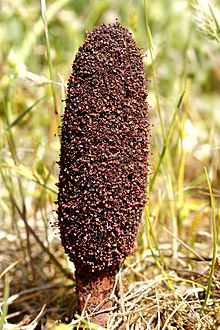| Cynomorium | |
|---|---|

| |
| Scientific classification | |
| Kingdom: | Plantae |
| Clade: | Tracheophytes |
| Clade: | Angiosperms |
| Clade: | Eudicots |
| Order: | Saxifragales |
| Family: | Cynomoriaceae Endl. ex Lindl.[1] |
| Genus: | Cynomorium L. |
| Species: | C. coccineum
|
| Binomial name | |
| Cynomorium coccineum | |
Cynomorium is a genus of parasitic perennial flowering plants in the family Cynomoriaceae.[2] The genus consists of only one species, Cynomorium coccineum (although one of its subspecies is sometimes treated as a separate species).[3] Its placement in the Saxifragales was resolved in 2016 with the help of nuclear, plastid, and mitochondrial sequences obtained from next-generation sequencing. Common names include the misleading Maltese fungus or Maltese mushroom; also desert thumb, red thumb, tarthuth (Bedouin) and suoyang (Chinese). A rare or local species, it grows in dry, rocky or sandy soils, often in salt marshes or other saline habitats close to the coast. It has had a wide variety of uses in European, Arabian and Chinese herbal medicine.[4][5][6]
- ^ Angiosperm Phylogeny Group (2009). "An update of the Angiosperm Phylogeny Group classification for the orders and families of flowering plants: APG III". Botanical Journal of the Linnean Society. 161 (2): 105–121. doi:10.1111/j.1095-8339.2009.00996.x. hdl:10654/18083.
- ^ "Melita Historica 3(1960)1(53-70) Cynomorum Coccineum Linn.,A Maltese Historical Plant. Guido G. Lanfranco". Archived from the original on 2019-06-06. Retrieved 2019-08-24.
- ^ Christenhusz, M. J. M.; Byng, J. W. (2016). "The number of known plants species in the world and its annual increase". Phytotaxa. 261 (3): 201–217. doi:10.11646/phytotaxa.261.3.1.
- ^ M. Blamey; C. Grey-Wilson (2004). Wild Flowers of the Mediterranean. London: A&C Black. p. 33.
- ^ ITM Online: CYNOMORIUM: Parasitic Plant Widely Used in Traditional Medicine, by Subhuti Dharmananda, Ph.D., plus The Treasure of Tarthuth, by R.W. Lebling, Jr. (accessed 19 April 2011, 22:24 GMT)
- ^ The historical guide to the island of Malta and its dependencies. p. 88-89.